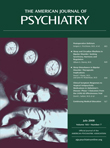To the Editor: We thank Dr. Siu for her letter commenting on our article. Dr. Siu identifies two psychometric issues that should be considered when interpreting standardized T scores for individuals with schizophrenia. She notes that even when raw test scores follow symmetrical and asymptotic normal distributions for the normative and target patient samples, there can be difficulties in interpreting T scores and their percentile equivalents. Additionally, she states that extrapolation is necessary for patient T score values that are not captured within the range of normative sample raw test scores and asks for the range of scores by test in our study.
Regarding the distribution of scores in the normative sample, each MCCB test was examined for normality of score distribution. The primary measures from the Trail Making Test, Part A; the Hopkins Verbal Learning Test—Revised; and the Neuropsychological Assessment Battery Mazes subtest required log transformation to address problems in skewness. The MCCB scoring program uses these transformed scores in calculating the T scores and percentiles for each test and, hence, provides a reference that is normally distributed. Parenthetically, in the patient sample in our study, only the Trail Making Test, Part A from the final MCCB required transformation to normalize the distribution. Dr. Siu’s point regarding the relationship between standard score values and their corresponding percentiles applies to any neuropsychological assessment of individuals with clinical disorders. As a result of the way that these scores are derived, percentile scores change most in relation to standard scores when they fall near the median of the normative distribution, and they change least when they fall at the tails. The proportion of individuals represented within the tail of the normal curve was necessarily small.
Dr. Siu is correct that relatively few subjects in the community normative sample scored at extremely low levels. However, the accuracy of the T scores for these low performance levels was not dependent on the few subjects who scored low, but rather on the extent to which the distribution of the entire normative sample met the assumption of a normal distribution of scores. To be fair, the range in which one is most likely to see deviations from normality and, hence, risks to accuracy falls within the tails, but this is also the range in which one is least able to determine the normality, since it provides the least amount of data. To the extent that patient scores overlapped the community sample and the normality assumption was met, the percentiles were reasonably accurate and meaningful. As requested by Dr. Siu, we provide the following range of raw scores from the community sample for each MCCB test in our study (means and standard deviations appear in the online data supplement according to age group): Trail Making Test: Part A (seconds): range=12–80; Brief Assessment of Cognition in Schizophrenia: Symbol Coding (total correct): range=21–86; Hopkins Verbal Learning Test-Revised (total recall trials 1–3): range=9–36; Wechsler Memory Scale-III: Spatial Span (total correct): range=5–25; Letter-Number Span (total correct): range=5–24; Neuropsychological Assessment Battery: Mazes (total raw score): range=2–26; Brief Visuospatial Memory Test-Revised (total recall trials, 1–3): range=5–36; Category fluency: animal naming (total correct): range=8–39; Mayer-Salovey-Caruso Emotional Intelligence Test: Managing Emotions (branch score): range=68–117; Continuous Performance Test-Identical Pairs Version (mean d-prime across 2-, 3-, and 4-digit conditions): range=0.45–4.24.
It is worth noting that within a clinical trials context to assess the efficacy of promising new compounds, investigators who utilize the MCCB will be primarily interested in assessing change in cognition over time, which is best measured on the T score rather than percentile scale. The MCCB provides a standardized method of measurement to assess test performance across multiple cognitive domains and evaluate the efficacy of new compounds for this purpose. Furthermore, the use of T scores based on a community sample as the primary metric allows investigators to consider the extent to which a potential cognitive enhancer improves the cognitive performance of a clinical group relative to typical performance levels in the community.

